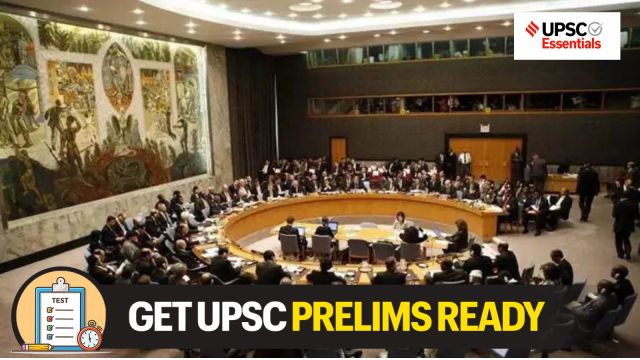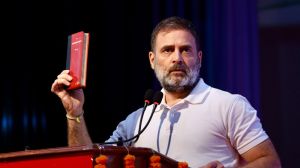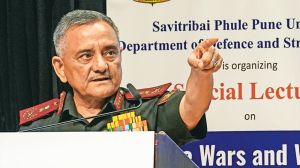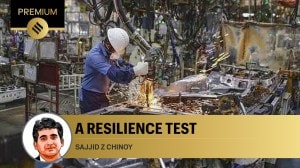UPSC Prelims 2025 Special: Revision Checklist for important International Organisations and Places in News that aspirants shouldn’t miss
UPSC CSE Prelims 2025: International organisations and places in the news are classic 'if you know, you know' (IYKYK) topics — often the make-or-break factor in clearing the cut-off. With Prelims just 4 days away, are they on your checklist? Take a quick look.
 Here’s a must-check list of important international organisations and places in news to revisit in your notes or compilations. Don’t miss them during your final revision
Here’s a must-check list of important international organisations and places in news to revisit in your notes or compilations. Don’t miss them during your final revisionAre You Prelims Ready? The UPSC Civil Services Preliminary Examination 2025 is scheduled for May 25. With the clock ticking, revising Current Affairs—especially International Bodies and Places in News—is crucial for every aspirant. Here’s a must-check list of key International Bodies and Places in News before your examination. Don’t miss them during your final revision.
PREVIOUS CHECKLISTS: Environment (Click here), Sci-Tech (Click here), CSAT (Click here), Economy – Part 1 (Click here), Part 2 (Click here).
1. World Economic Forum
— The World Economic Forum (WEF) hosted its annual meeting in Davos, Switzerland, in January 2025.
— Klaus Schwab, a German professor, formed the World Economic Forum in 1971, previously known as the European Management Forum.
— The WEF is primarily funded by its partner corporations, which are typically worldwide companies with annual revenues of more than $5 billion.
— The WEF is committed to the ideals of independence, impartiality, moral integrity, and intellectual honesty.
2. International Criminal Court
— The ICC’s founding instrument, known as the Rome Statute, allows it jurisdiction over four major crimes: genocide, crimes against humanity, war crimes, and the crime of aggression.
— The crime of genocide is distinguished by the specific intent to destroy in whole or in part a national, ethnic, racial, or religious group by killing its members or inflicting substantial bodily or mental harm on members of the group.
— The International Criminal Court (ICC) can pursue crimes against humanity, which are significant violations committed as part of a large-scale attack on a civilian population.
— War crimes are serious violations of the Geneva Conventions in the context of armed conflict, such as the use of child soldiers, the killing or torture of civilians or prisoners of war, and the intentional targeting of hospitals, historic monuments, or buildings dedicated to religion, education, art, science, or charitable purposes.
— Crime of aggression is the use of armed force by a State against the sovereignty, integrity or independence of another State.
3. QUAD
— QUAD is an informal organisation of countries that includes Australia, India, Japan, and the United States. It was an endeavour of the Trump administration during his first term. The Biden administration elevated it to the position of leadership.
— Following the Indian Ocean tsunami in December 2004, India, Japan, Australia, and the United States formed an informal alliance to coordinate disaster relief efforts. Shinzo Abe, Japan’s then-Prime Minister, codified the partnership in 2007 as the Quadrilateral Security Dialogue, or the Quad.
Cancer Moonshot Initiative
— US President Joseph R. Biden hosted the fourth Quad Leaders’ Summit in Wilmington, Delaware on September 21, 2024.
— The Quad grouping took a groundbreaking cancer initiative globally known as the Quad Cancer Moonshot Initiative. The countries — India, United States, Australia and Japan — launched the programme that will focus on expanding cervical cancer screening; increasing vaccinations against the human papillomavirus, or HPV, a common sexually transmitted infection that is the primary cause of cervical cancer; and treating patients.
4. BRICS
— Indonesia has officially joined the BRICS as a full member, the Brazilian government declared. Brazil, Russia, India, China, South Africa, and Indonesia presently make up the group of big emerging economies.
— Brazil, which will hold the BRICS presidency in 2025, said that member nations unanimously approved Indonesia’s entry at the 2023 BRICS summit in Johannesburg. BRICS has been extending its membership in recent years. Along with Indonesia, the bloc includes Egypt, Ethiopia, Iran, and the United Arab Emirates, demonstrating its expanding influence in emerging countries.
— Formation: In July 2006, the leaders of the BRIC countries (Brazil, Russia, India, and China) met for the first time in St. Petersburg, Russia, on the fringes of the G8 Outreach Summit. Following a series of high-level meetings, the first BRIC summit took place on June 16, 2009, in Yekaterinburg, Russia.
5. Rural Community Immigration Class
— The Rural Community Immigration Class is a new program introduced by Immigration, Refugees, and Citizenship Canada (IRCC) in December 2024.
— Its goal is to address workforce shortages and foster development in tiny rural towns by recruiting people who want to live there for the long term.
— For students whose PGWPs are about to expire and who are failing to satisfy the Comprehensive Ranking System (CRS) score for PR or get high-paying jobs, this program provides an excellent chance.
6. H-1B visa
— According to the US Department of Labour, the H-1B visa program allows US firms to hire immigrant workers in specialty jobs that demand “a high level of skill” and “at least a bachelor’s degree”. H-1B visas can be awarded for up to six years at a time.
— “The H-1B provisions intend to help employers who cannot otherwise obtain needed business skills and abilities from the US workforce by authorising the temporary employment of qualified individuals who are not otherwise authorised to work in the United States,” according to the department’s online presence.
— According to US Citizenship and Immigration Services (USCIS), Indians account for 72.3% (2.79 lakh out of 3.86 lakh) of H-1B visa holders in fiscal year 2023.
7. Non-permanent members of the UNSC
— The five members (Pakistan, Panama, Somalia, Denmark, and Greece) were elected by a secret ballot in the UN General Assembly for a 2-year term starting on January 1, 2025, until December 31, 2026. In a secret poll, the chosen countries obtained the needed two-thirds majority of Member States present and voting in the 193-member General Assembly.
— According to the UN Charter, the 15-member Security Council (ten non permanent and five permanent) is primarily responsible for ensuring international peace and security, and all Member States are required to comply with its decisions.
— The ten non-permanent seats on the Security Council are divided into four regional groups: Africa and Asia; Eastern Europe; Latin America and the Caribbean; and Western European and other States.
— India has been elected as a non-permanent member of the Council (eight times) for the years 1950-1951, 1967-1968, 1972-1973, 1977-1978, 1984-1985, 1991-1992, 2011-2012, and 2021-2022.
Note: Five permanent members: China, France, the Russian Federation, the United Kingdom, and the United States.
8. African Union
— The African Union (AU) is an intergovernmental organisation of the 55 member states located on the continent of Africa.
— It was officially established in 2002 as the successor of the Organisation of African Unity (OAU, 1963-1999).
— The African Union Commission, the organization’s secretariat, is headquartered in Addis Ababa. The organisation has a combined GDP of $3 trillion and 1.4 billion people.
— The official languages of the Union and its institutions will be Arabic, English, French, Portuguese, Spanish, Kiswahili, and any other African language.
(au.int)
9. G20
— The Group of Twenty (G20) consists of 19 countries (Argentina, Australia, Brazil, Canada, China, France, Germany, India, Indonesia, Italy, Japan, Republic of Korea, Mexico, Russia, Saudi Arabia, South Africa, Turkey, the United Kingdom, and the United States) as well as two regional bodies: the European Union and the African Union (as of 2023).
— The G20 countries account for around 85% of global GDP, over 75% of global trade, and almost two-thirds of the world’s population.
10. United Nations Human Rights Council (UNHRC)
— It is an intergovernmental body responsible for strengthening the promotion and protection of human rights around the globe.
— It is in charge of bolstering global efforts to promote and defend human rights.
— The 47-member Council offers a multilateral forum for discussing national circumstances and breaches of human rights.
— It offers suggestions on how to more effectively apply human rights in practice and react to emergencies involving human rights.
— It convenes in UNOG, the United Nations Office in Geneva.
Responsibilities
— Provides a global platform for discussion of human rights concerns with representatives of the United Nations
— Adopts resolutions or judgements at regular sessions that represent the global community’s position on certain human rights matters or circumstances.
— Calls special sessions, or crisis meetings, to address pressing human rights issues.
— Review each United Nations Member State’s human rights record.
11. World Trade Organization
— The World Trade Organization is the only international organization that deals with the rules of trade between countries.
— It was founded in 1995, the WTO is run by its 164 members, and according to its rules, all decisions are taken through consensus and any member can exercise a veto.
— It aims to promote free trade, which is done through trade agreements that are discussed and signed by the member states.
— The WTO also provides a forum for countries to negotiate trade rules and settle economic disputes.
— The Ministerial Conference is the WTO’s top decision-making body and usually meets every two years. All members of the WTO are involved in the Ministerial Conference and they can make decisions on all matters covered under any multilateral trade agreements.
12. 16th United Nations Biodiversity Conference (COP16)
— The 16th United Nations Biodiversity Conference (COP16) in Cali, Colombia, concluded without consensus on a new fund to protect nature, halting discussions.
— The negotiations ran 12 hours behind schedule due to a lack of quorum, prompting Colombian Environment Minister Susana Muhamad to suspend the session after many negotiators had gone.
— COP16 made some accomplishments, such as establishing a subsidiary organisation to incorporate indigenous views into future biodiversity negotiations.
— The conference’s primary goal was to monitor progress towards the 2022 Kunming-Montreal Global Biodiversity Framework (KM-GBF), which aims to safeguard 30% of global land and sea areas and restore 30% of degraded ecosystems by 2030.
— Currently, roughly $400 million has been pledged to the Global Biodiversity Framework Fund (GBFF), but environmentalists warn that this amount is insufficient to stop biodiversity loss.
13. International Solar Alliance
— The International Solar Alliance is the first international treaty-based organisation that enables co-operation among sun-rich countries lying fully or partially between the Tropics of Cancer and Capricorn.
— It was established following the Paris Declaration at the UN Climate Change Conference on November 30, 2015. The International Solar Alliance was unveiled by Prime Minister Narendra Modi and then French President Francois Hollande.
— The maiden summit of the International Solar Alliance was hosted by India while the co-host was France.
— ISA was envisaged as a facilitator, or a force multiplier, which would help countries overcome financial, technological, regulatory, or other barriers in harnessing solar energy.
14. G7
— The G7 arose from a 1973 summit of finance ministers and central bank governors in Paris, France. This summit was held in response to serious economic issues at the time, including an oil crisis, growing inflation, and the collapse of the Bretton Woods system. The US dollar’s value was fixed against gold.
— The inaugural G7 summit, held in 1975 at Rambouillet, France, brought together the leaders of France, Germany, the United Kingdom, the United States, Italy, and Japan.
— Since 1977, officials from the European Economic Community, now known as the European Union, have also participated.
— Russia’s accession in 1998 enlarged the group to the G8, however, its participation was suspended in 2014 due to the annexation of Crimea.
15. Shanghai Cooperation Organisation
— The origin of the Shanghai Cooperation Organisation lies in the “Shanghai Five”, formed in 1996 and consisting of China, Russia, Kazakhstan, Kyrgyzstan and Tajikistan.
— On June 15, 2001, the Shanghai Cooperation institution (SCO) was created as an international institution, with Uzbekistan joining as the sixth member.
— It had ten members: India, Iran, Kazakhstan, China, Kyrgyzstan, Pakistan, Russia, Tajikistan, Uzbekistan and Belarus. (latest member to join: Belarus). Afghanistan and Mongolia hold Observer Status.
— The official languages of the SCO are Russian and Chinese.
(eng.sectsco.org)
16. ASEAN
— On August 8, 1967, five Southeast Asian leaders – the Foreign Ministers of Indonesia, Malaysia, the Philippines, Singapore, and Thailand met in Bangkok. Thailand was mediating certain conflicts between Malaysia, Indonesia, and the Philippines, and the occasion eventually resulted in the signing of a document.
— Over the next several decades, five more countries joined: Brunei Darussalam, Lao PDR, Cambodia, Myanmar, and Vietnam.
— The ten-nation group has an anthem, a flag, and biannual meetings (twice a year) with a rotating chairperson.
— ASEAN is key to India’s ‘Act East’ policy, which focuses on the Asia-Pacific region as an extended neighbourhood. It was developed as the next phase in the ‘Look East’ Policy, which began in the 1990s.
17. Extended Fund Facility
— An EFF is a financial assistance package offered by the IMF to countries facing severe balance of payments issues due to structural weaknesses that cannot be resolved in the short term.
— In theory, it is meant to help the borrowing country implement medium-term structural reforms. In Pakistan’s case, these include bolstering monetary and fiscal policies including tax reforms, strengthening competition, and rebuilding the forex reserves.
— EFF “aims to capitalise on the hard-won macroeconomic stability achieved over the past year by furthering efforts to strengthen public finances, reduce inflation, rebuild external buffers and remove economic distortions to spur private sector led growth.”
— However, the package does not include plans to restructure the country’s external and internal debt.
18. Mineral Security Partnership (MSP) Finance Network
— India is now formally a part of the Minerals Security Finance Network, a US-led initiative aiming to strengthen cooperation among members to secure supply chains for critical minerals.
— The Minerals Security Finance Network (MSFN) is a new initiative that emerged from the Minerals Security Partnership (MSP), a framework established by the United States in 2022. India was included in the MSP in June 2023.
— India’s inclusion was especially significant because one of the core components of New Delhi’s economic strategy is an ambitious change in the mobility area, involving the conversion of a large portion of public and private transportation to electric vehicles.
19. European Free Trade Association (EFTA)
— EFTA is an intergovernmental grouping of Iceland, Liechtenstein, Norway and Switzerland.
— The deal brings in $100 billion in investment over 15 years, with the EFTA looking at joint ventures that will help India diversify imports away from China.
— India signed a trade agreement with the four-nation EFTA. India could see investment flow into the pharma, chemical sectors, food processing and engineering sectors.
20. Pacific Islands Forum (PIF)
— PIF is an intergovernmental organisation which consists of 18 member states located in the Pacific region. It was formed in 1971.
— Pacific Island countries: Australia, Cook Islands, Federated States of Micronesia, Fiji, French Polynesia, Kiribati, Nauru, New Caledonia, New Zealand, Niue, Palau, Papua New Guinea, Republic of Marshall Islands, Samoa, Solomon Islands, Tonga, Tuvalu, and Vanuatu.
— The countries of this grouping are among the world’s worst-affected countries due to rising sea levels. Australia and New Zealand are among the wealthiest and largest countries which are part of the organisation.
— The organisation discusses priority issues at its annual meeting, where decisions made by the member states are reached by consensus. The decisions are implemented by the Pacific Islands Forum Secretariat.
21. Security of Supply Arrangement (SOSA)
— SOSA requires the United States and India to offer reciprocal priority support for goods and services that promote national defence. The US Department of Defence (DoD) stated that it will “enable both countries to acquire the industrial resources they need from one another to resolve unanticipated supply chain disruptions to meet national security needs”.
— India is the 18th SOSA partner of the US.
22. India-Middle East-Europe Economic Corridor (IMEC)
— The IMEC is a connectivity project that aims to create a seamless network of ports, trains, roads, marine lines, and pipelines to boost trade between India, the Arabian Peninsula, the Mediterranean region, and Europe.
— The IMEC Memorandum of Understanding (MoU) was signed in September 2023 in New Delhi during the G-20 summit by India, Saudi Arabia, the United Arab Emirates (UAE), France, Germany, Italy, the United States, and the European Union.
— In addition to the signatories to the MoU, Israel and Greece are two important nodal sites in IMEC who have expressed interest in joining the project.
23. United Nations International Children’s Emergency Fund (UNICEF)
— The United Nations General Assembly and Ludwik Rajchman formed UNICEF on December 11, 1946, to address the needs of children in countries impacted by World War II and to provide emergency help to war-stricken children and mothers.
— UNICEF’s mandate was expanded in 1950 to address the long-term needs of children and women in developing countries, following an initial focus on food and healthcare in postwar Europe and China.
— It became a permanent member of the United Nations system in 1953, retaining its mission to fight for the rights of children, aid in meeting their basic requirements, and provide them with opportunities to reach their full potential.
— Its mission was to assist children and young people whose lives and futures were in danger, regardless of what role their country had played in the conflict.
24. UN Peacekeeping missions
— India would continue to provide training and capacity-building programs, including courses specifically targeted for women peacekeepers, through initiatives headed by the Centre for UN Peacekeeping, as it did with ASEAN countries in 2023, according to Jaishankar. India strongly thinks that peacekeeping is an effective tool for maintaining world peace and security.
— Since the 1950s, India has sent over 290,000 peacekeepers to more than 50 UN peacekeeping missions, according to Jaishankar. Currently, more than 5,000 Indian troops are stationed in nine of the eleven active peacekeeping missions.
— The concept of UN peacekeeping originates from the UN’s lack of armed forces. As a result, Member States voluntarily provide military and police personnel as needed for each peacekeeping mission from their own national forces.
— Peacekeepers often wear their own countries’ uniforms and are recognisable as UN peacekeepers simply by a UN blue helmet or beret and insignia. They are tasked with protecting people, actively preventing conflict, decreasing violence, increasing security, and equipping national institutions to carry out these functions.
25. Places in News
(a) Ring of Fire
— The Ring of Fire is a series of hundreds of volcanoes and earthquake sites that stretch along the Pacific Ocean. It is formed like a semicircle or horseshoe and covers roughly 40,250 km.
— According to National Geographic, the Ring of Fire marks the meeting points of numerous tectonic plates, including the Eurasian, North American, Juan de Fuca, Cocos, Caribbean, Nazca, Antarctic, Indian, Australian, Philippine, and other smaller plates that all encircle the large Pacific Plate.
— It runs through the USA, Indonesia, Mexico, Japan, Canada, Guatemala, Russia, Chile, Peru, and the Philippines.
(b) Mayotte
— The storm caused high gusts, flash floods, and landslides, causing authorities to declare a red alert. The prefect of Mayotte, François-Xavier Bieuville, reported that severe rains had caused significant damage.
(c) Great Bitter Lake
— The Great Bitter Lake is one of several lakes along the Suez Canal, which connects the eastern Mediterranean and the Red Sea.
(d) Gulf of Mexico
— The Gulf of Mexico is a semi-enclosed sea that borders the USA and Mexico and covers approximately 1.5 million square kilometers. The northern Gulf is topographically complex and is a rich source of oil and gas deposits, which has led to a great deal of research on benthic ecosystems from the coastal zone to the deep sea.
— The Gulf of Mexico is bordered by three countries: the United States, Mexico and Cuba.
— The Gulf is a productive sea with lucrative fisheries in addition to oil and gas. Exploitation of natural resources and potential climate change impacts threaten vulnerable ecosystems in the Gulf, including those in the deep sea.
(www.usgs.gov)
(e) Greenland
— Greenland is an autonomous territory of the Kingdom of Denmark that obtained its home government in 1979.
— Greenland, with a population of around 57,000, is the world’s largest island. Since 2009, it has had the authority to hold a referendum to determine whether to pursue independence.
— It is located in the North Atlantic Ocean, between Europe and North America, across the Baffin Bay from Canada.
— Its strategic importance grew during the Cold War, and the United States maintains a massive air base there, the Pituffik Space Base, formerly the Thule Air Base. The United States can monitor and prevent any missiles approaching Greenland from Russia, China, or possibly North Korea. Similarly, it is easier to fire missiles and ships from Greenland to Asia or Europe.
— Greenland is rich in rare earth minerals, which are used to make mobile phones, electric vehicles, and other consumer electronics, as well as bombs and other weaponry. Currently, China is a major supplier of these minerals. In 2021, Greenland approved legislation prohibiting uranium mining.
(f) Panama Canal
— The Panama Canal had long been envisioned, owing to the high expense and time required to get from one ocean to the other by circumnavigating South America.
— It was constructed between 1904 and 1914, primarily because of US contributions. Until then, the region’s distinctive terrain made building a canal problematic. France had already abandoned similar projects due to their enormous cost.
— Colombia ruled Panama until 1903, when a US-backed coup helped the country gain independence. The Hay-Bunau-Varilla Treaty of 1903 granted the United States rights to build and maintain the canal, as well as permanent rights over the Panama Canal Zone.
— The island is located in the northeastern part of the Bay of Bengal, near the boundary between Bangladesh and Myanmar.
— It is nine kilometres from the southernmost point of Bangladesh’s Cox’s Bazar-Teknaf peninsula. It is Bangladesh’s only coral island, with reefs stretching 10-15 km to the west-northwest. It also serves as a breeding site for sea turtles.
— The island was previously part of the Teknaf peninsula (around 5,000 years ago), but it progressively sank into the sea. The southern suburbs of present-day St Martin’s Island resurfaced some 450 years ago, with the northern and rest of the island rising above sea level during the next 100 years.
(h) Chancay Port
— The vast $3.6 billion project, funded by China’s Belt and Road Initiative (BRI), has also generated concerns in US policy making circles about Chinese influence in an area that has long been considered its backyard.
— The port is located about 78 km north of the Peruvian capital of Lima, Chancay is a small fishing town with a population of around 60,000. It is a natural deep-water port, however, previous feasibility studies on building up infrastructure pointed out heavy construction costs.
(i) Ireland
— Ireland is providing an intriguing chance for residents with the necessary immigration documents to relocate to its picturesque offshore villages.
— As part of the ‘Our Living Islands’ initiative, the government is offering major economic incentives to attract people to move to the country’s islands. According to Euro News, this program intends to revitalise Ireland’s offshore communities and secure their long-term survival.
(j) Suez Canal
— The Suez Canal is the 193-km artificial waterway that connects the Red Sea to the Mediterranean through the Isthmus of Suez.
— It reduced the maritime path from Asia to Europe by up to 7,000 kilometres by eliminating the requirement for ships to pass around the southern tip of Africa to connect the Indian and Atlantic Oceans.
— There is some evidence that a canal was built in the region during the era of Pharaoh Senausret III, who ruled in the second millennium BC. However, the idea for the contemporary canal dates back to the seventeenth century, when European colonial expansion was at its pinnacle.
— Today, it is one of the world’s busiest waterways, accounting for over 12 per cent of global business.
(k) Westbank
— The West Bank is bordered by Israel on three sides and Jordan on the east. It also shares a boundary with the Dead Sea to the southeast.
— The Jordan River defines the eastern border of the Westbank.
(l) Diego Garcia
— Britain has agreed to give up sovereignty of the Chagos Islands to Mauritius, ending a long-standing dispute over the United Kingdom’s last African colony, after the International Court of Justice (ICJ) ruled that the UK unlawfully separated the Chagos archipelago from Mauritius before granting it independence.
— As part of the pact, the UK will maintain control of the UK-US military post on Diego Garcia. Previously, the UK evacuated 1,500 to 2,000 residents in order to lease the island to the United States for military purposes, with both countries sharing responsibility for the base. The treaty also grants the right of return to all islands in the Chagos archipelago, except Diego Garcia.
— Diego Garcia is the largest island of the Chagos Archipelago which is located in the central Indian Ocean.
(m) Zimbabwe
— Zimbabwe plans to cull 200 elephants to provide food for communities severely impacted by the worst drought in four decades.
— The El Nino-induced drought has devastated southern Africa, leading to widespread crop failures and leaving 68 million people facing food shortages across the region.
— Southern Africa is home to one of the world’s largest elephant populations, with over 200,000 elephants living across a conservation area that spans Zimbabwe, Zambia, Botswana, Angola, and Namibia.
— This marks the first elephant cull in Zimbabwe since 1988.
(n) United Arab Emirates
— The United Arab Emirates has finished the Barakah Nuclear Energy Plant, the Arab world’s first nuclear power plant, according to a statement from the state-owned Emirates Nuclear Energy Corporation (ENEC).
— The Barakah Nuclear Energy Plant is located near Al Dhafra, in the Emirate of Abu Dhabi on the Arabian Gulf, approximately 53 kilometres west-southwest of the city of Ruwais.
(o) Atacama salt flat
— Chile’s Atacama salt flat is sinking at a pace of 1 to 2 cm per year as a result of lithium brine extraction, a process in which salt-rich water is pumped to the surface and into a series of evaporation ponds to extract lithium.
— This is happening because pumping occurs quicker than aquifer recharge, resulting in subsidence, or downward vertical displacement of the Earth’s surface.
— According to the report, the affected area is around 8 kilometres north and south by 5 kilometres east and west.
(p) Nigeria
— According to recent research conducted by many international development partners, more than 31.8 million Nigerians are currently experiencing severe food shortages.
— According to the Nigerian government, the problem is exacerbated by continued security concerns and the elimination of fuel subsidies.
(q) Amazon rainforests
— Deforestation in the Amazon, which encompasses approximately 40% of South America, is typically associated with agricultural growth and illegal mining.
— The Amazon rainforest spans nine countries: Brazil, Suriname, Peru, Venezuela, Colombia, French Guiana, Ecuador, Bolivia, and Guyana.
(r) Darfur region
— Sudan, according to the World Food Programme (WFP), is experiencing the world’s worst hunger crisis, with the western Darfur region being particularly vulnerable as Sudan’s 15-month civil war, which has uprooted millions and spurred ethnic bloodshed, continues.
— The war, sparked by a desire to combine the army and paramilitary forces in a transition to free elections, has resulted in waves of ethnically motivated bloodshed blamed primarily on the RSF.
All the best!
Edited by Khushboo Kumari
Subscribe to our UPSC newsletter and stay updated with the news cues from the past week.
The UPSC articles of Indian Express is now on Telegram. Join our Telegram channel- Indian Express UPSC Hub and stay updated with the latest Updates.
Must Read
Buzzing Now
Jun 04: Latest News
- 01
- 02
- 03
- 04
- 05


























